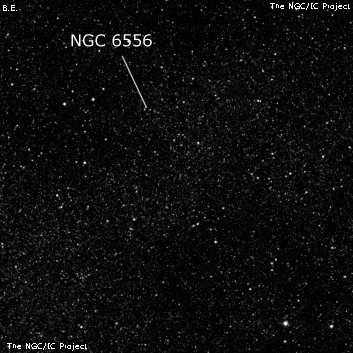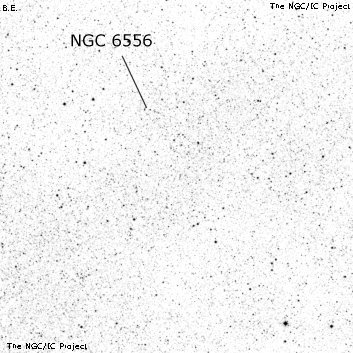NGC/IC Project Restoration Effort
(This is a very very beta version)
NGC6556


Basic Information
Location and Magnitude
Right Ascension: 18:9:56.0
Declination: -27:31:27
Constellation: SGR
Visual Magnitude:
Historic Information
Discoverer: Herschel J.
Year of discovery: 1836
Discovery aperture: 18.3
Observational
Summary description: F, vL, cE, lbM, rr
Sub-type: *Grp
Corwin's Notes
=====
NGC 6556. The problems with this object began with Sir John himself and his
summary description published in the GC, then copied faithfully into the NGC.
That description makes the object "F, vL, cE, lbM, rr." On the other hand,
JH's original notes read
"Cl VI. An oval patch comprised within limits of the field, barely
resolvable into infinitely minute points, but which, without attention,
appears as a great nebula 15' l; 12' br; hardly bM."
Howe saw it the same way 65 years later: "I see nothing in the entire region
except thousands of the minutest stars." Dreyer summarized this in the IC2
Notes simply as "No nebulosity (Ho)."
The object is actually part of the complex region of star clouds and obscuring
dust clouds near the Galactic Center. JH's position points to an otherwise
unremarkable part of the Milky Way, comprised of, as both he and Howe saw,
"... thousands of the minutest stars." This is an apt description.
I've adopted a position just an arcminute south of JH's place, and make the
cloud -- in the red DSS2 image -- nearly as large as he did.
Steve's Notes
=====
NGC 6556
24" (7/7/13): very bright but patchy Milky Way field, rich in faint stars at 125x (21mm Ethos). Excellent region to scan, although no distinct boundaries or dark clouds to isolate the object, so does not stand out conspicuously. The position, though, was easy to identify as an as a large triangle (sides ~12') with four mag 7-8 stars (including HD 165873, 165708, 165787) is off the southwest side.



